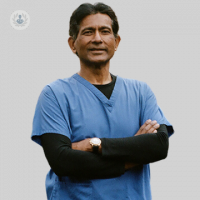What are the symptoms and signs of scoliosis?
Written in association with:Scoliosis, a condition marked by an abnormal sideways curvature of the spine, affects many individuals, particularly during adolescence. Renowned consultant orthopaedic spinal surgeon Professor Hilali Noordeen sheds light on its symptoms, causes, and treatment options, helping patients understand this condition and the pathways to effective management and care.

What is scoliosis?
Scoliosis is a condition characterised by an abnormal lateral curvature of the spine. Instead of maintaining a straight, vertical line, the spine curves to the side, forming an "S" or "C" shape. While scoliosis can occur at any age, it most commonly presents during the growth spurt just before puberty. As an orthopaedic spinal surgeon, I often see patients with varying degrees of this condition, from mild cases requiring monitoring to severe curvatures that necessitate surgical intervention.
What are the symptoms and signs of scoliosis?
Scoliosis often develops gradually, and in many cases, the symptoms are not immediately noticeable. Common signs to look out for include uneven shoulders, one shoulder blade that appears more prominent than the other, uneven waist, and one hip higher than the other. In more severe cases, scoliosis can cause back pain and discomfort, respiratory issues due to reduced chest space, and, in extreme cases, can impact heart function.
How is scoliosis diagnosed?
Diagnosing scoliosis typically begins with a physical examination. During this examination, the patient is asked to bend forward at the waist so that the spine can be viewed more clearly. This is known as the Adam's forward bend test.
If scoliosis is suspected, further imaging tests, such as X-rays, are conducted to confirm the diagnosis and measure the degree of curvature. The angle of the curve is measured in degrees using the Cobb method, and this measurement is crucial in determining the appropriate treatment plan.
What causes scoliosis?
The exact cause of scoliosis is often unknown, which is termed idiopathic scoliosis. However, several factors can contribute to the development of this condition. These include genetic predisposition, as scoliosis tends to run in families, and certain neuromuscular conditions like cerebral palsy and muscular dystrophy, which can lead to imbalances in the spine's muscular support. Congenital scoliosis, resulting from malformations of the spine present at birth, and degenerative scoliosis, due to age-related changes in the spine, are other identified causes.
What treatment options are available for scoliosis?
Scoliosis treatment is tailored to the patient's age and the severity of the curve. For mild scoliosis, regular monitoring and follow-up appointments are often sufficient to ensure the curve does not worsen. Moderate scoliosis may require bracing to prevent further curvature, particularly in growing children and adolescents. The brace is designed to hold the spine in a straighter position and is typically worn until the patient stops growing.
In severe cases, where the curvature is greater than 45 degrees and continues to progress, surgical intervention may be necessary. The most common surgical procedure is spinal fusion, which involves connecting two or more of the vertebrae to correct and stabilise the curve. Metal rods, screws, and hooks are often used to hold the spine in the correct position during the healing process.
How can scoliosis impact daily life?
Living with scoliosis can present challenges, particularly if the condition is severe. Pain and discomfort can affect daily activities, and the visible curvature may lead to self-esteem issues, especially in adolescents. However, with appropriate treatment and support, many individuals with scoliosis lead active and fulfilling lives. Physiotherapy and exercise can help manage symptoms, improve posture, and enhance overall spinal health.
By understanding scoliosis and exploring the available treatment options, patients and their families can make informed decisions and take proactive steps towards managing this condition effectively. As always, consulting with a specialist is crucial for personalised care and guidance.
If you have concerns about scoliosis and would like to book a consultation with Professor Noordeen, do not hesitate to do so by visiting his Top Doctors profile today.


